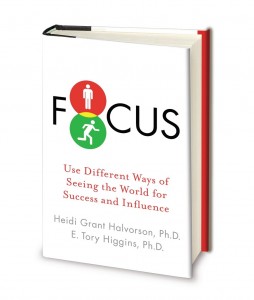FOCUS in Paperback – Preorder Now!
Very excited to announce that FOCUS is now available for preorder in paperback, and ships January 28th! To check it out on Amazon, click here:
Click on this link to download the free FOCUS companion workbook!
Here are some of my favorite posts on promotion and prevention focus:
How to Get Better at Spotting Opportunities (HBR)
Is Your Focus Promotion or Prevention? (Dan Pink)
Master Your Motivation to Boost Your Career (CNN)
How to Walk Away (The Atlantic)
How Happiness Changes With Age (The Atlantic)
Do You Play to Win or Not Lose? (HBR)
And here’s the book trailer:
New Research: Rituals Make Us Value Things More
The Key to Giving Great Feedback: Focus on the Process, Not the Person
Rule #1: When things go wrong, keep it real.
Rule #2: When things go wrong, fight self-doubt.
- Make your advice specific. What exactly can your team member do improve? When you are a leader, helping others figure out how to do it right is just as important as letting them know what they are doing wrong.
- Emphasize actions that she has the power to change. Talk about aspects of her performance that are under her control, like the time and effort she put into a project, or the strategic approach she used.
- Avoid praising effort. Studies show that being complimented for “effort” after a failure not only makes people feel stupid, but also leaves them feeling incapable of reaching their goal. In these instances, it’s really best to stick topurely informational feedback – if effort isn’t the problem, figure out what is, and let the employee know.
Rule #3: When things go right, avoid praising ability.
The 8 Motivational Challenges
Here’s the description:
How do you get someone who’s putting in low effort to put in more?
How can you get someone who is reluctant to take on new tasks embrace challenge?
How can you get a good performer to perform even better?
There is no one-size-fits-all way to get people motivated. Anyone who tells you that you should do X to get the most out of your employees, your students, or even yourself, isn’t telling you that – at best – X only works for some of the people, some of the time.
In The 8 Motivational Challenges, renowned Social Psychologist Heidi Grant Halvorson identifies the eight different types of underperformers and draws on research from her books Succeed and Focus to offer tailored strategies for lighting a fire under each one:
1. The Teenager
2. The Showoff
3. The Neurotic
4. The Stick in the Mud
5. The Eager Beaver
6. The Alert Apprentice
7. The Star Who’s (Almost) Born
8. The Expert in the Making
Underperformers range from the truly achievement-challenged to those who are actually performing at a high level, but could perform even better if someone knew the right way to motivate them. Halvorson explains how we can understand each profile in terms of the mindset and motivational focus they bring to their work, in addition to the confidence with which they approach it. For each profile, she lays out specific, evidence-based strategies for increasing effectiveness and engagement.
We differ from one another in countless ways. What we need is to somehow identify meaningful differences between people. Succinct and focused, this prescriptive guide will appeal to readers of What Successful People Do Before Breakfast and 9 Things Successful People Do Differently.
Check out the Science of Thriving Schedule for Sept 16-20!
2:00pm PT/5:00pm ET: Nine Things Successful People Do Differently with Dr. Heidi Grant Halvorson
3:00pm PT/6:00pm ET: To Sell is Human with Daniel Pink
4:00pm PT/7:00pm ET: Choke: The Secret to Performing Under Pressure with Sian Beilock
5:00pm PT/8:00pm ET: The Honest Truth About Dishonestly: How We Lie to Everyone, Especially Ourselves with Dan Ariely
2:00pm PT/5:00pm ET: Focus: Use Different Ways of Seeing the World for Success and Influence with Tory Higgins
3:00pm PT/6:00pm ET: Sidetracked: Why Our Decisions Get Derailed and How We Can Stick to the Plan with Francesca Gino
4:00pm PT/7:00pm ET: Confidence: Overcoming Low Self-Esteem, Insecurity, and Self-Doubt with Dr. Tomas Chamorro-Premuzic
5:00pm PT/8:00pm ET: The 3 Secrets to Effective Time Investment with Elizabeth Saunders
2:00pm PT/5:00pm ET: Ungifted: Intelligence Refined (The Truth About Talent, Practice, Creativity, & The Many Paths to Greatness) with Scott Barry Kaufman
3:00pm PT/6:00pm ET: Smart Thinking with Art Markman
4:00pm PT/7:00pm ET: Compelling People with Amy Cuddy
5:00pm PT/8:00pm ET: The Antidote: The Power of Negative Thinking with Oliver Burkeman
2:00pm PT/5:00pm ET: Self-Compassion: Stop Beating Yourself Up and Leave Insecurity Behind with Kristin Neff
3:00pm PT/6:00pm ET: Mindset: The New Science of Success with Carol Dweck
4:00pm PT/7:00pm ET: Give and Take: A Revolutionary Approach to Success with Adam Grant
5:00pm PT/8:00pm ET: Mastermind: How To Think Like Sherlock Holmes with Maria Konnikova
6:00pm PT/9:00pm ET: What Most Successful People Do Before Breakfast with Laura Vanderkam
2:00pm PT/5:00pm ET: How Children Succeed: Grit, Curiosity, & The Hidden Power of Character with Paul Tough
3:00pm PT/6:00pm ET: Drunk Tank Pink: And Other Unexpected Forces that Shape How We Think, Feel, and Behave with Adam Alter
4:00pm PT/7:00pm ET: Social: Why Our Brains Are Wired to Connect with Matt Lieberman
5:00pm PT/8:00pm ET: Brilliant: The Science of Smart with Annie MurphyPaul
6:00pm PT/9:00pm ET: The Myths of Creativity with David Burkus
- « Previous Page
- 1
- 2
- 3
- 4
- 5
- 6
- …
- 19
- Next Page »


